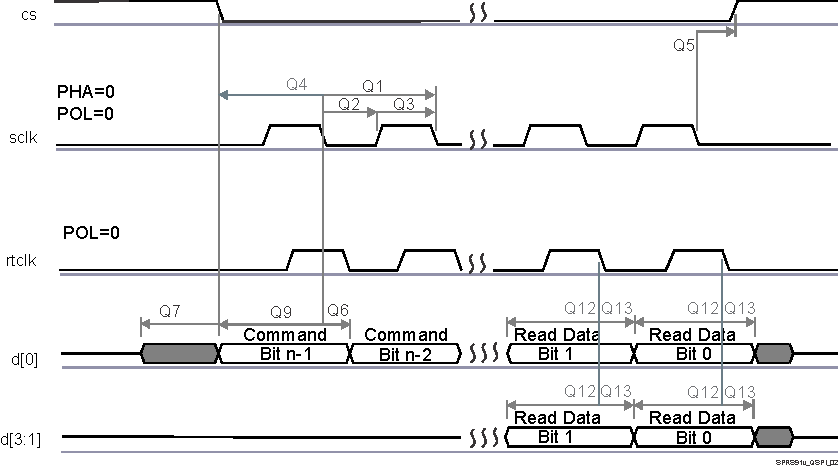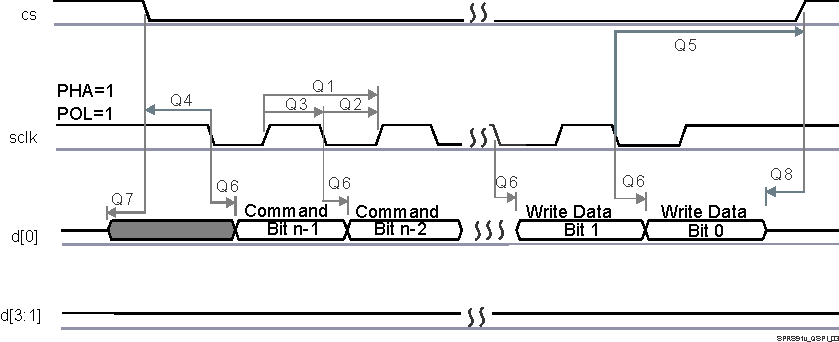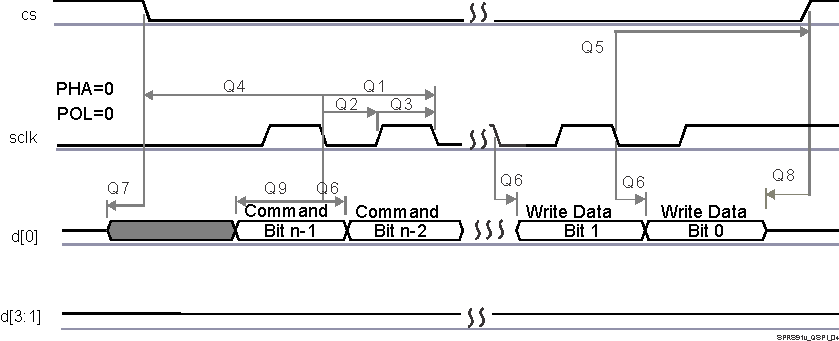SPRS964H June 2016 – February 2020 TDA3LA , TDA3LX , TDA3MA , TDA3MD , TDA3MV
PRODUCTION DATA.
- 1 Device Overview
- 2 Revision History
- 3 Device Comparison
-
4 Terminal Configuration and Functions
- 4.1 Terminal Assignment
- 4.2 Ball Characteristics
- 4.3 Multiplexing Characteristics
- 4.4
Signal Descriptions
- 4.4.1 Video Input Ports (VIP)
- 4.4.2 Display Subsystem – Video Output Ports
- 4.4.3 Digital-to-Analog Converter (SD_DAC)
- 4.4.4 Embedded 8 channel Analog-To-Digital Converter (ADC)
- 4.4.5 Camera Control
- 4.4.6 Camera Parallel Interface (CPI)
- 4.4.7 Imaging Subsystem (ISS)
- 4.4.8 External Memory Interface (EMIF)
- 4.4.9 General-Purpose Memory Controller (GPMC)
- 4.4.10 Timers
- 4.4.11 Inter-Integrated Circuit Interface (I2C)
- 4.4.12 Universal Asynchronous Receiver Transmitter (UART)
- 4.4.13 Multichannel Serial Peripheral Interface (McSPI)
- 4.4.14 Quad Serial Peripheral Interface (QSPI)
- 4.4.15 Multichannel Audio Serial Port (McASP)
- 4.4.16 Controller Area Network Interface (DCAN and MCAN)
- 4.4.17 Ethernet Interface (GMAC_SW)
- 4.4.18 SDIO Controller
- 4.4.19 General-Purpose Interface (GPIO)
- 4.4.20 Pulse-Width Modulation Subsystem (PWMSS)
- 4.4.21 Test Interfaces
- 4.4.22 System and Miscellaneous
- 4.4.23 Power Supplies
-
5 Specifications
- 5.1 Absolute Maximum Ratings
- 5.2 ESD Ratings
- 5.3 Power-On Hours (POH)
- 5.4 Recommended Operating Conditions
- 5.5 Operating Performance Points
- 5.6 Power Consumption Summary
- 5.7
Electrical Characteristics
- 5.7.1 LVCMOS DDR DC Electrical Characteristics
- 5.7.2 Dual Voltage LVCMOS I2C DC Electrical Characteristics
- 5.7.3 IQ1833 Buffers DC Electrical Characteristics
- 5.7.4 IHHV1833 Buffers DC Electrical Characteristics
- 5.7.5 LVCMOS Analog OSC Buffers DC Electrical Characteristics
- 5.7.6 LVCMOS CSI2 DC Electrical Characteristics
- 5.7.7 Dual Voltage LVCMOS DC Electrical Characteristics
- 5.8 Thermal Characteristics
- 5.9 Analog-to-Digital ADC Subsystem Electrical Specifications
- 5.10 Power Supply Sequences
- 6 Clock Specifications
-
7 Timing Requirements and Switching Characteristics
- 7.1 Timing Test Conditions
- 7.2 Interface Clock Specifications
- 7.3 Timing Parameters and Information
- 7.4 Recommended Clock and Control Signal Transition Behavior
- 7.5 Video Input Ports (VIP)
- 7.6 Display Subsystem – Video Output Ports
- 7.7 Imaging Subsystem (ISS)
- 7.8 External Memory Interface (EMIF)
- 7.9 General-Purpose Memory Controller (GPMC)
- 7.10 General-Purpose Timers
- 7.11 Inter-Integrated Circuit Interface (I2C)
- 7.12 Universal Asynchronous Receiver Transmitter (UART)
- 7.13 Multichannel Serial Peripheral Interface (McSPI)
- 7.14 Quad Serial Peripheral Interface (QSPI)
- 7.15
Multichannel Audio Serial Port (McASP)
- Table 7-26 Timing Requirements for McASP1
- Table 7-27 Timing Requirements for McASP2
- Table 7-28 Timing Requirements for McASP3
- Table 7-29 Switching Characteristics Over Recommended Operating Conditions for McASP1
- Table 7-30 Switching Characteristics Over Recommended Operating Conditions for McASP2
- Table 7-31 Switching Characteristics Over Recommended Operating Conditions for McASP3
- 7.16 Controller Area Network Interface (DCAN and MCAN)
- 7.17
Ethernet Interface (GMAC_SW)
- 7.17.1 GMAC MDIO Interface Timings
- 7.17.2
GMAC RGMII Timings
- Table 7-39 Timing Requirements for rgmiin_rxc - RGMIIn Operation
- Table 7-40 Timing Requirements for GMAC RGMIIn Input Receive for 10/100/1000 Mbps
- Table 7-41 Switching Characteristics Over Recommended Operating Conditions for rgmiin_txctl - RGMIIn Operation for 10/100/1000 Mbit/s
- Table 7-42 Switching Characteristics for GMAC RGMIIn Output Transmit for 10/100/1000 Mbps
- 7.18 SDIO Controller
- 7.19 General-Purpose Interface (GPIO)
- 7.20
Test Interfaces
- 7.20.1
JTAG Electrical Data/Timing
- Table 7-53 Timing Requirements for IEEE 1149.1 JTAG
- Table 7-54 Switching Characteristics Over Recommended Operating Conditions for IEEE 1149.1 JTAG
- Table 7-55 Timing Requirements for IEEE 1149.1 JTAG With RTCK
- Table 7-56 Switching Characteristics Over Recommended Operating Conditions for IEEE 1149.1 JTAG With RTCK
- 7.20.2 Trace Port Interface Unit (TPIU)
- 7.20.1
JTAG Electrical Data/Timing
-
8 Applications, Implementation, and Layout
- 8.1 Introduction
- 8.2 Power Optimizations
- 8.3 Core Power Domains
- 8.4 Single-Ended Interfaces
- 8.5 Differential Interfaces
- 8.6 Clock Routing Guidelines
- 8.7 LPDDR2 Board Design and Layout Guidelines
- 8.8 DDR2 Board Design and Layout Guidelines
- 8.9
DDR3 Board Design and Layout Guidelines
- 8.9.1 DDR3 General Board Layout Guidelines
- 8.9.2
DDR3 Board Design and Layout Guidelines
- 8.9.2.1 Board Designs
- 8.9.2.2 DDR3 Device Combinations
- 8.9.2.3 DDR3 Interface Schematic
- 8.9.2.4 Compatible JEDEC DDR3 Devices
- 8.9.2.5 PCB Stackup
- 8.9.2.6 Placement
- 8.9.2.7 DDR3 Keepout Region
- 8.9.2.8 Bulk Bypass Capacitors
- 8.9.2.9 High Speed Bypass Capacitors
- 8.9.2.10 Net Classes
- 8.9.2.11 DDR3 Signal Termination
- 8.9.2.12 VTT
- 8.9.2.13 CK and ADDR_CTRL Topologies and Routing Definition
- 8.9.2.14 Data Topologies and Routing Definition
- 8.9.2.15 Routing Specification
- 8.10 CVIDEO/SD-DAC Guidelines and Electrical Data/Timing
- 9 Device and Documentation Support
- 10Mechanical, Packaging, and Orderable Information
Package Options
Refer to the PDF data sheet for device specific package drawings
Mechanical Data (Package|Pins)
- ABF|367
Thermal pad, mechanical data (Package|Pins)
Orderable Information
7.14 Quad Serial Peripheral Interface (QSPI)
The Quad SPI (QSPI) module is a type of SPI module that allows single, dual or quad read access to external SPI devices. This module has a memory mapped register interface, which provides a direct interface for accessing data from external SPI devices and thus simplifying software requirements. It works as a master only. There is one QSPI module in the device and it is primary intended for fast booting from quad-SPI flash memories.
General SPI features:
- Programmable clock divider
- Six pin interface (DCLK, CS_N, DOUT, DIN, QDIN1, QDIN2)
- 4 external chip select signals
- Support for 3-, 4- or 6-pin SPI interface
- Programmable CS_N to DOUT delay from 0 to 3 DCLKs
- Programmable signal polarities
- Programmable active clock edge
- Software controllable interface allowing for any type of SPI transfer
NOTE
For more information, see the Quad Serial Peripheral Interface section of the Device TRM.
Table 7-23 and Table 7-24 present Timing and Switching Characteristics for Quad SPI Interface.
Table 7-23 Switching Characteristics for QSPI
| No | PARAMETER | DESCRIPTION | Mode | MIN | MAX | UNIT |
|---|---|---|---|---|---|---|
| 1 | tc(SCLK) | Cycle time, sclk | Default Timing Mode, Clock Mode 0 | 10.4 | ns | |
| Default Timing Mode, Clock Mode 3 | 15.625 | ns | ||||
| 2 | tw(SCLKL) | Pulse duration, sclk low | Y×P-1 (1) | ns | ||
| 3 | tw(SCLKH) | Pulse duration, sclk high | Y×P-1 (1) | ns | ||
| 4 | td(CS-SCLK) | Delay time, sclk falling edge to cs active edge, CS3:0 | Default Timing Mode | -M×P-1 (2)(3) | -M×P+1 (2)(3) | ns |
| 5 | td(SCLK-CS) | Delay time, sclk falling edge to cs inactive edge, CS3:0 | Default Timing Mode | N×P-1 (2)(3) | N×P+1 (2)(3) | ns |
| 6 | td(SCLK-D1) | Delay time, sclk falling edge to d[0] transition | Default Timing Mode | -1 | 1 | ns |
| 7 | tena(CS-D1LZ) | Enable time, cs active edge to d[0] driven (lo-z) | -P-3.5 | -P+2.5 | ns | |
| 8 | tdis(CS-D1Z) | Disable time, cs active edge to d[0] tri-stated (hi-z) | -P-2.5 | -P+2.0 | ns | |
| 9 | td(SCLK-D1) | Delay time, sclk first falling edge to first d[0] transition | PHA=0 Only, Default Timing Mode | -1-P | -1-P | ns |
- The Y parameter is defined as follows: If DCLK_DIV is 0 or ODD then, Y equals 0.5. If DCLK_DIV is EVEN then, Y equals (DCLK_DIV/2) / (DCLK_DIV+1). For best performance, it is recommended to use a DCLK_DIV of 0 or ODD to minimize the duty cycle distortion. The HSDIVIDER on CLKOUTX2_H13 output of DPLL_PER can be used to achieve the desired clock divider ratio. All required details about clock division factor DCLK_DIV can be found in the device-specific Technical Reference Manual.
- P = SCLK period.
- M=QSPI_SPI_DC_REG.DDx + 1 when Clock Mode 0. M=QSPI_SPI_DC_REG.DDx when Clock Mode 3. N = 2 when Clock Mode 0. N = 3 when Clock Mode 3.
 Figure 7-30 QSPI Read (Clock Mode 3)
Figure 7-30 QSPI Read (Clock Mode 3)  Figure 7-31 QSPI Read (Clock Mode 0)
Figure 7-31 QSPI Read (Clock Mode 0) CAUTION
The IO Timings provided in this section are only valid when all QSPI Chip Selects used in a system are configured to use the same Clock Mode (either Clock Mode 0 or Clock Mode 3).
Table 7-24 Timing Requirements for QSPI
| No | PARAMETER | DESCRIPTION | MODE | MIN | MAX | UNIT |
|---|---|---|---|---|---|---|
| 12 | tsu(D-RTCLK) | Setup time, d[3:0] valid before falling rtclk edge | Default Timing Mode, Clock Mode 0 | 2.9 | ns | |
| tsu(D-SCLK) | Setup time, d[3:0] valid before falling sclk edge | Default Timing Mode, Clock Mode 3 | 5.7 | ns | ||
| 13 | th(RTCLK-D) | Hold time, d[3:0] valid after falling rtclk edge | Default Timing Mode, Clock Mode 0 | -0.1 | ns | |
| th(SCLK-D) | Hold time, d[3:0] valid after falling sclk edge | Default Timing Mode, Clock Mode 3 | 0.1 | ns | ||
| 14 | tsu(D-SCLK) | Setup time, final d[3:0] bit valid before final falling sclk edge | Default Timing Mode, Clock Mode 3 | 5.7-P (1) | ns | |
| 15 | th(SCLK-D) | Hold time, final d[3:0] bit valid after final falling sclk edge | Default Timing Mode, Clock Mode 3 | 0.1+P (1) | ns |
- P = SCLK period.
- Clock Modes 1 and 2 are not supported.
- The Device captures data on the falling clock edge in Clock Mode 0 and 3, as opposed to the traditional rising clock edge. Although non-standard, the falling-edge-based setup and hold time timings have been designed to be compatible with standard SPI devices that launch data on the falling edge in Clock Modes 0 and 3.
 Figure 7-32 QSPI Write (Clock Mode 3)
Figure 7-32 QSPI Write (Clock Mode 3)  Figure 7-33 QSPI Write (Clock Mode 0)
Figure 7-33 QSPI Write (Clock Mode 0) NOTE
To configure the desired virtual mode the user must set MODESELECT bit and DELAYMODE bit field for each corresponding pad control register.
The pad control registers are presented in Table 4-3 and described in Device TRM, Control Module section.
CAUTION
The IO timings provided in this section are only valid if signals within a single IOSET are used. The IOSETs are defined in Table 7-25.
In Table 7-25 are presented the specific groupings of signals (IOSET) for use with QSPI.
Table 7-25 QSPI IOSETs
| SIGNALS | IOSET1 | IOSET2 | IOSET3 | IOSET4 | ||||
|---|---|---|---|---|---|---|---|---|
| BALL | MUX | BALL | MUX | BALL | MUX | BALL | MUX | |
| qspi1_sclk | C8 | 1 | C8 | 1 | C8 | 1 | C8 | 1 |
| qspi1_rtclk | C14 | 8 | B7 | 1 | F13 | 5 | D8 | 2 |
| qspi1_d0 | B9 | 1 | B9 | 1 | B9 | 1 | B9 | 1 |
| qspi1_d1 | F10 | 1 | F10 | 1 | F10 | 1 | F10 | 1 |
| qspi1_d2 | A9 | 1 | A9 | 1 | A9 | 1 | A9 | 1 |
| qspi1_d3 | D10 | 1 | D10 | 1 | D10 | 1 | D10 | 1 |
| qspi1_cs0 | E10 | 1 | E10 | 1 | E10 | 1 | E10 | 1 |
| qspi1_cs1 | F15 | 5 | F15 | 5 | F15 | 5 | F15 | 5 |